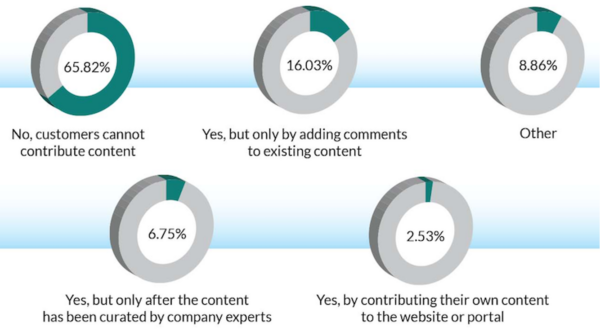
Dana Aubin, Comtech Services
September 1, 2022
CIDM members shared their experiences and questions about user-generated content at last month’s roundtable. Our definition of user-generated content included community portals, discussion forums, YouTube videos, social media posts, tweets, articles, blogs, podcasts, and other content created by the users of a product or service and shared online. During our discussion, this definition expanded to include both customer-generated and developer-generated content.
In our last trends survey in 2020, less than 3 percent of those surveyed responded that their companies allowed users to contribute content directly to the website or portal. Around 7 percent allowed users to add curated content. However, 66 percent of companies didn’t allow customers to contribute content. When we looked back at the surveys from 2017 through 2019, results have only changed a percent or two.
2020 CIDM Trends Survey results for user-generated content

During our discussion, we found that the current state of user-generated content hasn’t changed much since the last survey. Of the companies that were represented at the roundtable, a few have customer portals with user-generated documentation already in place. Other companies are working toward it.
Most of the attendees were looking forward to hearing how other companies have integrated user-generated content and lessons learned. Here are some highlights of our discussion.
Advantages
The advantages of user-generated content include:
- Quicker answers
- Build customer loyalty
- Build community trust
- Engage customer
- Decrease content development costs
- Attain fresh perspective
Although everyone agreed on these advantages, a member suggested that we reframe the conversation to focus on our goals. Why do we want to create user-centered content? What problem are we trying to solve? That person suggested that although the advantages listed might be goals, the real issue facing technical writing teams is they “never seem to have enough resources to be able to do what they want to be able to do,” which leads to gaps in the documentation. Customers who find those gaps may have the answers and want to share them, especially for products and industries with strong communities. Once those gaps are identified and analyzed, the content can be added to the official product documentation or vetted for the customer portal.
“We have customers who are begging to contribute.”
Members also mentioned that customers and implementation partners also document things that are unique or specific to the customer’s configuration or goals. Although this type of information may not belong in the product documentation, it can help other customers in the current form or evolve into the company’s best practices.
One member mentioned that user-generated content would help technical writers to better understand customers. Specifically at their company, but likely at many others, barriers are in place that keep writers from accessing customers directly. Letting customers contribute content would let them “talk” to the writers so that the writers know what their customers need.
“(User-generated content) helps the writers understand what the clients need.”
Barriers
Possible barriers to making user-generated content a reality include:
- Sustainable mechanisms/process
- Concerns about accuracy, quality, and liability
- Lack of participation
- Skewed content

Of these barriers, only the first two concerns were voiced during the roundtable discussion. Both technical writing and engineering teams are concerned about having enough resources to review user-generated content to ensure the accuracy of the information before it is shared with other customers.
Participation was not seen as a barrier and members shared that their users are eager to contribute their knowledge and provide feedback on the product documentation. In fact, the users of one company’s solutions are “desperate to contribute.”
No one mentioned worries about skewed content.
Developer-generated content
Although companies seem slow to adopt user-generated content, content drafted by the product team, specifically developers, was common at members’ companies. Members shared success stories along with challenges and unintended consequences.
Developer-generated content is not shared directly with customers; it first goes through product documentation processes. This poses a challenge when there are not enough technical writers to review content, which affects the extent to which the technical writing team can improve the content. At some companies, writers have time only to copyedit the content. Other companies use the full gamut of technical writers’ skills to improve their product.
When writers are relegated to copy editing, or worse, “making it pretty,” they may lose job satisfaction. Even more serious, technical writers and the profession may lose value in the eyes of the company. This concern was shared by multiple managers. A member shared an experience where the product was moving at a pace where writers couldn’t add value other than just editing “bad” writing. Once the product development slowed down, writers were able to return to good technical writing processes.
Summary
Technical writing teams want to enable users to contribute content, but the main barriers are a lack of resources and concerns about accuracy and liability.
For companies that have customer portals that allow user-generated content, the two issues mentioned were:
- Lack of resources to review the content to incorporate it into the product documentation
- No federated search between user-generated content and product documentation
Although few companies allow users to share content directly or indirectly with other customers, companies are letting users contribute user feedback on the product documentation. The feedback is routed to writers through workflows so that writers can update the information.
Members stressed the importance of providing a platform for users to share information with other users. “It’s going to happen anyway,” one member stated. In fact, multiple members mentioned that customers have “secret portals” to share content.
If you have experiences to share about user-generated content, please continue the discussion in the CIDM group on LinkedIn or in the CIDM Member Slack workspace. Others would love to hear your tales.
